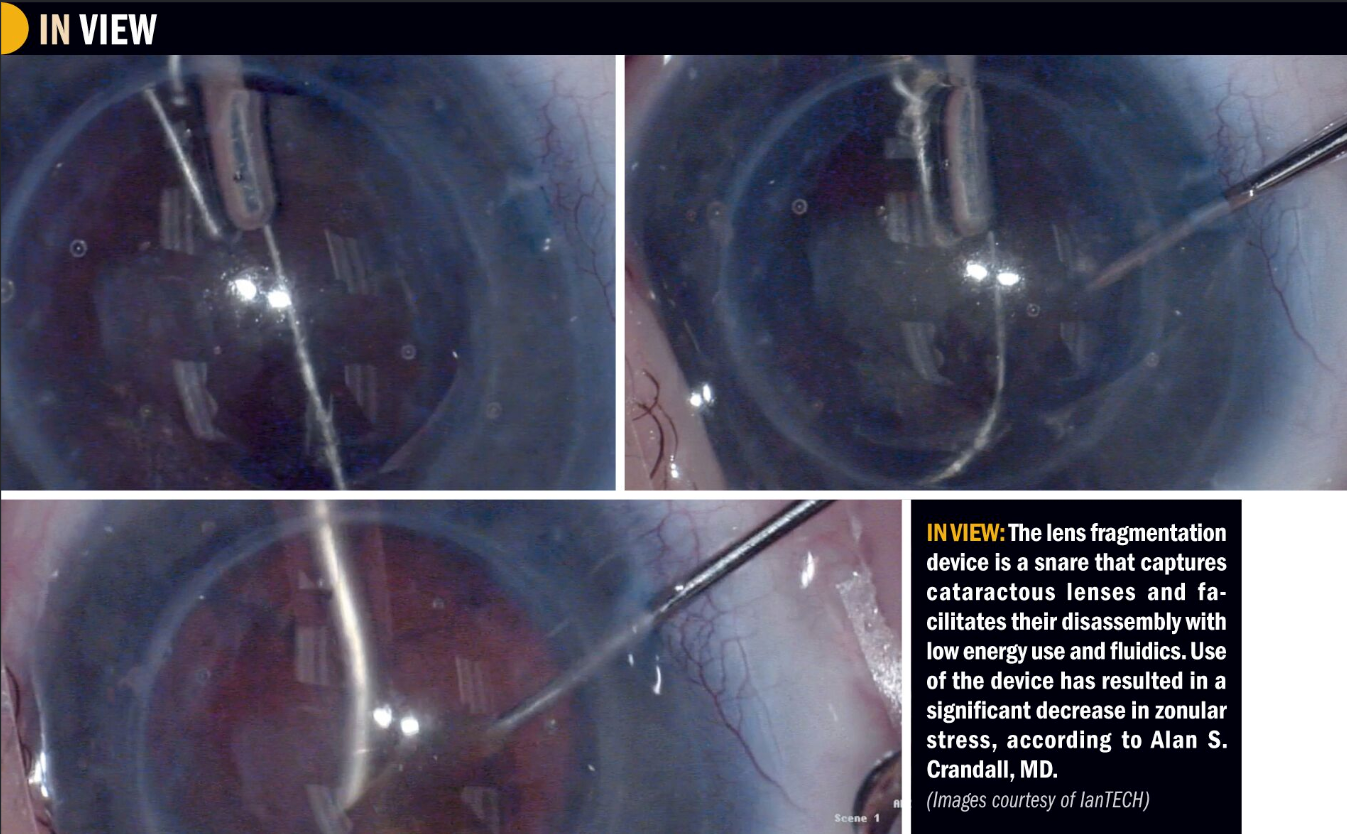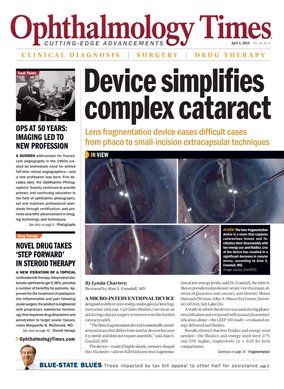Publication
Article
Digital Edition
Device manages complex cataract
Author(s):
Lens fragmentation device eases difficult cases from phaco to small-incision extracapsular techniques

The lens fragmentation device is a snare that captures cataractous lenses and facilitates their disassembly with low energy use and fluidics.
Reviewed by Alan S. Crandall, MD
A micro-interventional device designed to deliver zero-energy endocapsular lens fragmentation (miLoop, Carl Zeiss Meditec) serves as an aid during cataract surgery to remove even the hardest cataracts safely.
“The [lens fragmentation device] is essentially a modernized snare that differs from similar devices because it is sterile and does not require assembly,” said Alan S. Crandall, MD.
The device-made of highly elastic, memory-shaped thin filaments-allows full-thickness lens fragmentation at low-energy levels, said Dr. Crandall, the John A. Moran presidential professor; senior vice chairman; director of glaucoma and cataract; and director, Moran Outreach Division, John A. Moran Eye Center, University of Utah, Salt Lake City.
A study in which the device was used during phacoemulsification and compared with manual phacoemulsification alone-the LEEP 103 study-evaluated energy delivered and fluidics.
Results showed that less fluidics and energy were needed-the fluidics and energy used were 27% and 53% higher, respectively (p < 0.05 for both comparisons).
Dr. Crandall described how use of the lens fragmentation device has resulted in a significant decrease in zonular stress.
“This device is very zonular-friendly compared with other methods of chopping,” Dr. Crandall said. “The device is very helpful in cases of hard cataracts and gets through them very easily.”
Dealing with uncomplicated cataract cases is one thing, but complicated cases is another, Dr. Crandall added.
For a congenital coloboma, no zonules were visible in one area, which raised the question about the value of the use of the lens fragmentation device in this scenario. In this instance, Dr. Crandall said he avoids lens rotation because of the compromised zonules.
The advantage in this case is the lens fragmentation device facilitated hemisection of the nucleus and the sections were removed by phacoemulsification.
The eye can be easily manipulated during the procedure. If lens rotation is desired, as might occur in an eye with a less mature cataract, the entire lens can be rotated and sectioned into quadrants as many times as desired, according to Dr. Crandall.
Dr. Crandall noted that a small learning curve associated with use of the lens fragmentation device is easily managed, and he is learning new techniques over time with its use.
“The [lens fragmentation device] is especially valuable in the presence of hard cataracts,” he said.
Surgery in developing world
“Studies are ongoing in developing countries to determine if the amount of energy and learning curve can be reduced, and more importantly, reduce the incision size from 7.5 mm to 5.5 mm or less externally but maintain the self-sealing function and less invasiveness,” Dr. Crandall said.
Use of the lens fragmentation device can be helpful when teaching phacoemulsification, he added.
The most dangerous part of the procedure is dividing the lens. The device facilitates the division of the lens into quadrants. Students first can learn fluidics and then later the divide-and-conquer techniques.
Another advantage of this single-use disposable product is the cost effectiveness, saving the facility from having to allocate extra time and cost to cases that run past the allotted time on the surgery schedule.
“I encourage surgeons to look at the [lens fragmentation device],” Dr. Crandall. “It is especially useful when performing surgeries outside of the United States-it is a great tool.”
Disclosures:

Alan S. Crandall, MD
E: alan.crandall@hsc.utah.eduThis article was adapted from Dr. Crandall’s presentation at the 2018 meeting of the American Academy of Ophthalmology. Dr. Crandall has no financial interest in any aspect of this report.
Newsletter
Don’t miss out—get Ophthalmology Times updates on the latest clinical advancements and expert interviews, straight to your inbox.






